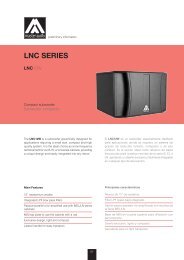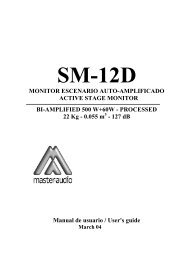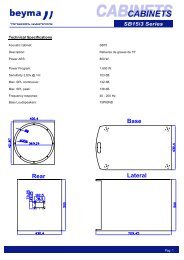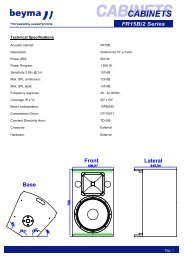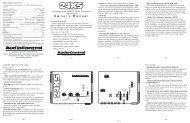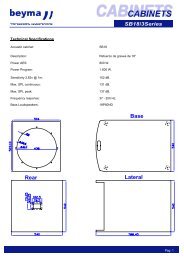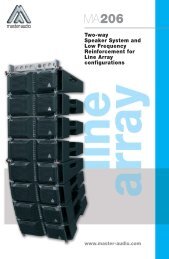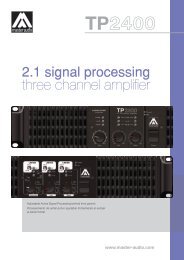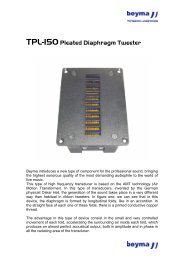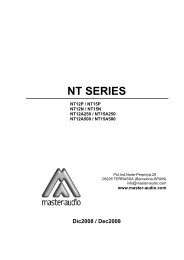LNC SERIES
LNC SERIES
LNC SERIES
Create successful ePaper yourself
Turn your PDF publications into a flip-book with our unique Google optimized e-Paper software.
<strong>LNC</strong> <strong>SERIES</strong><br />
<strong>LNC</strong>-12W<br />
<strong>LNC</strong>-15W<br />
Pol.Ind.Norte-Perpinyà,25<br />
08226 TERRASSA (Barcelona-SPAIN)<br />
Copyright © 2010 info@master-audio.com<br />
All rights reserved www.master-audio.com<br />
Feb 10<br />
Manual usuario / User’s manual
Master Audio<br />
ESPAÑOL<br />
1. INTRODUCCIÓN<br />
1.1. Generalidades<br />
Amate Electroacústica, s.l. le agradece la confianza depositada en nuestros<br />
productos de la Serie <strong>LNC</strong><br />
Le sugerimos lea atentamente las indicaciones que a continuación exponemos,<br />
confiando en que le serán de gran utilidad para obtener sus mejores resultados.<br />
1.2. Características y presentación<br />
<strong>LNC</strong>-12W<br />
- Refuerzo de bajas frecuencias<br />
- Altavoz de 12" de Neodimio<br />
- Capacidad de Potencia de 300 W r.m.s<br />
- Sensibilidad de 94 dB (1W/1m)<br />
- Fácil utilización en pasivo-paralelo / bi-amplificado con recintos de la serie B, EL ó<br />
LN.<br />
<strong>LNC</strong>-15W<br />
- Refuerzo de bajas frecuencias<br />
- Altavoz de 15" de Neodimio<br />
- Capacidad de Potencia de 400 W r.m.s<br />
- Sensibilidad de 98 dB (1W/1m)<br />
- Fácil utilización en pasivo-paralelo / bi-amplificado con recintos de la serie B, EL ó<br />
LN.<br />
2. CONEXIONES<br />
2.1. Descripción conexionado<br />
1 1<br />
Fig.1. Conexiones para <strong>LNC</strong>-12W / <strong>LNC</strong>-15W<br />
<strong>LNC</strong> Series. Version 1.0 Feb 10 2
Master Audio<br />
1 - SPEAKON : Todos los modelos incorporan dos terminales Speakon y están<br />
preparados para su perfecta conexión en un sistema en paralelo.<br />
ATENCIÓN: Utilice en lo posible cable-manguera de dos conductores, sin apantallar,<br />
bicolor y de buena calidad. Se recomienda el uso de una sección de 4mm 2 como<br />
mínimo para cada conductor.<br />
Evítese largas distancias de cableado ya que provocan importantes pérdidas de<br />
potencia y calidad.<br />
2.2. Configuraciones<br />
2.2.1. Configuración Estéreo<br />
Conectar cada salida del amplificador LEFT/RIGHT a cada unidad, mediante dos<br />
mangueras, independientemente.<br />
Fig.2. Configuración Estéreo<br />
2.2.2. Configuración en Pasivo con sistemas Full Range<br />
Muchas veces le interesará reforzar sus sistemas B/EL/LN Full Range mediante<br />
unidades subwoofer de la serie <strong>LNC</strong>, tanto en activo como en pasivo.<br />
En el caso pasivo, se dispondrá de un sólo amplificador para todo el sistema.<br />
De una de las salidas del amplificador conectar, mediante cable manguera, la unidad<br />
de graves.<br />
Posteriormente, efectuar un puente desde el conector Speakon esclavo del<br />
subwoofer a su respectiva unidad satélite de medios-agudos, respetando siempre la<br />
correcta polaridad entre ambos sistemas. Proceder de igual manera para el otro<br />
canal.<br />
También es correcto, si la instalación lo requiere, efectuar la conexión a la inversa,<br />
es decir, del amplificador al satélite y luego al subwoofer.<br />
<strong>LNC</strong> Series. Version 1.0 Feb 10 3
Master Audio<br />
Fig.3. Configuración en pasivo con unidades full range<br />
2.2.3. Configuración Bi-Amplificada con sistemas Full Range<br />
Del canal de salida de la etapa de potencia destinada a graves saldremos con una<br />
manguera de la mayor sección posible (4mm 2 mínimo) hacia uno de los subwoofers.<br />
Si se dispone de pareja de subwoofers, realizaremos una conexión en puente entre<br />
ambos, respetando siempre la polaridad.<br />
Conectar la otra salida del amplificador independientemente a la caja de mediosagudos.<br />
También es posible destinar un sólo amplificador para los refuerzos de graves,<br />
conectando cada uno de los subwoofers a las dos salidas de la etapa y en<br />
consecuencia, alimentar el sistema de medios-agudos mediante un segundo<br />
amplificador.<br />
Fig.4. Configuración bi-amplificada con unidades full range (opción 1)<br />
<strong>LNC</strong> Series. Version 1.0 Feb 10 4
Master Audio<br />
Fig.5. Configuración bi-amplificada con unidades full range (opción 2)<br />
¡ATENCIÓN!!!!: Para efectuar un puente entre cajas, cada una de ellas dispone de<br />
dos conectores idénticos Speakon que hacen la función de Entrada / Salida<br />
indistintamente. Siempre deben utilizarse los terminales Pin +1/-1, despreciando los<br />
terminales +2/-2 que no están conectados internamente.<br />
3. MONTAJE E INSTALACIÓN<br />
Para la adecuada instalación de los sistemas de cajas acústicas se recomienda lea<br />
atentamente los siguientes consejos.<br />
3.1. Posicionamiento<br />
Para posicionar las unidades de graves, es recomendable que éstas sean colocadas<br />
en el mismo suelo, ya que así se aprovecha, de forma natural, el llamado "efectosuelo"<br />
incrementando notoriamente la respuesta en bajas frecuencias.<br />
Le aconsejamos coloque, siempre que sea posible, las unidades de graves bajo el<br />
mismo eje acústico de dónde estén ubicados los satélites.<br />
Si esto no es posible deberían situarse en un punto intermedio entre los canales<br />
Izquierdo y Derecho.<br />
3.2. Utilización con sistemas full range<br />
Los modelos <strong>LNC</strong>-12W y <strong>LNC</strong>-15W incorporan integrado en su parte superior una<br />
pletina para cilindro de 35mm (diámetro de una barra estándar). Así podemos<br />
colocar de forma elevada sistemas acústicos que vayan provistos del vaso inferior<br />
para trípode. Evite colocar sistemas montados de esta forma en superficies<br />
inclinadas o irregulares.<br />
<strong>LNC</strong> Series. Version 1.0 Feb 10 5
Master Audio<br />
Fig.6. Posicionamiento con sistemas full range y barra<br />
3.3. Uso en aplicaciones de Directo (móvil)<br />
Para una aplicación móvil, para Directo o Discoteca, la ubicación clásica sería la de<br />
situar las unidades de graves (una ó dos por canal) a cada lado del escenario (sobre<br />
éste).<br />
Fig.7. Aplicaciones de directo<br />
Para conseguir una reproducción libre de obstáculos, se recomienda coloque las<br />
unidades de Medios-Agudos por encima de las unidades de graves a unos dos<br />
metros de altura.<br />
Si no se dispone de esta altura es conveniente utilizar el clásico trípode para cada<br />
caja y dejar las cajas de graves en el suelo.<br />
¡ATENCIÓN!!! En recintos con problemas de acústica y en los que es necesario<br />
reforzar la respuesta en bajas frecuencias es recomendable agrupar todos los<br />
subwoofers en un mismo punto. De esta manera evitaremos cancelaciones y<br />
obtendremos un nivel de presión acústica mucho más elevado.<br />
3.4. Volado<br />
Los subwoofers de la serie <strong>LNC</strong> no están preparados para ser volados.<br />
<strong>LNC</strong> Series. Version 1.0 Feb 10 6
Master Audio<br />
4. ESPECIFICACIONES<br />
4.1. Especificaciones <strong>LNC</strong>-12W<br />
Impedancia 4�<br />
Sensibilidad 1W/1m 94dB<br />
Respuesta en frecuencia (-10 dB) 42Hz-170Hz<br />
Capacidad de potencia<br />
R.M.S 300W�<br />
Programa 600W<br />
Directividad nominal (-6dB) omnidireccional<br />
Componentes 1x12" woofer neodimio<br />
Recinto<br />
Altura 367mm<br />
Anchura 550 mm<br />
Profundidad 450 mm<br />
Peso (neto) 16 Kg<br />
Conectores 2 x Speakon (IN/LINK)<br />
Material Tablero abedul<br />
Acabado Pintura negra de resinas acrílicas, ecológica a base de agua<br />
4.2. Especificaciones <strong>LNC</strong>-15W<br />
Impedancia 4�<br />
Sensibilidad 1W/1m 98dB<br />
Respuesta en frecuencia (-10 dB) 36Hz-160Hz<br />
Capacidad de potencia<br />
R.M.S 400W�<br />
Programa 800W<br />
Directividad nominal (-6dB) omnidireccional<br />
Componentes 1x15" woofer neodimio<br />
Recinto<br />
Altura 450 mm<br />
Anchura 660 mm<br />
Profundidad 490 mm<br />
Peso (neto) 24 Kg<br />
Conectores 2 x Speakon (IN/LINK)<br />
Material Tablero abedul<br />
Acabado Pintura negra de resinas acrílicas, ecológica a base de agua<br />
<strong>LNC</strong> Series. Version 1.0 Feb 10 7
Master Audio<br />
5. APÉNDICE.PÉRDIDA DE POTENCIA (EN %) Y FACTOR DE DAMPING, RELATIVA A<br />
LA LONGITUD DEL CABLE Y SU SECCIÓN<br />
Largo<br />
cable<br />
(m)<br />
1<br />
5<br />
10<br />
20<br />
50<br />
Sección<br />
(mm 2 )<br />
Resistencia<br />
(Ohms)<br />
Pérdida de Potencia<br />
8Ohms 4Ohms 2Ohms<br />
Pérdida<br />
Damping(*)<br />
8Ohms 4 Ohms<br />
0.75 0.042 0.53% 1.05% 2.10% 98 49<br />
1.50 0.025 0.31% 0.63% 1.25% 123 62<br />
2.50 0.013 0.16% 0.33% 0.65% 151 75<br />
4.00 0.008 0.10% 0.20% 0.40% 167 83<br />
0.75 0.210 2.63% 5.25% 10.5% 32 16<br />
1.50 0.125 1.56% 3.13% 6.25% 48 24<br />
2.50 0.065 0.81% 1.63% 3.25% 76 38<br />
4.00 0.040 0.50% 1.00% 2.00% 100 50<br />
0.75 0.420 5.25% 10.50% 21.00% 17 9<br />
1.75 0.250 3.13% 6.25% 12.50% 28 14<br />
2.50 0.130 1.63% 3.25% 6.50% 47 24<br />
4.00 0.080 1.00% 2.00% 4.00% 67 33<br />
0.75 0.840 10.50% 21.00% 42.00% 9 5<br />
1.50 0.500 6.25% 12.50% 25.00% 15 7<br />
2.50 0.260 3.25% 6.50% 13.00% 27 13<br />
4.00 0.160 2.00% 4.00% 8.00% 40 20<br />
0.75 2.100 26.25% 52.50% --- 4 2<br />
1.50 1.250 15.63% 31.25% 62.50% 6 3<br />
2.50 0.650 8.13% 16.25% 32.50% 12 6<br />
4.00 0.400 5.00% 10.00% 20.00% 18 9<br />
(*) Referido a un amplificador con un Factor de Amortiguamiento de 200:1.<br />
Las secciones de cable inferiores a 2.50 mm 2 deben desconsiderarse.<br />
Para instalaciones fijas con cargas a 4 Ohms, es preferible disponer de un cable por<br />
Sistema de Altavoces. No es aconsejable "puentear" las cajas entre sí.<br />
<strong>LNC</strong> Series. Version 1.0 Feb 10 8
Master Audio<br />
ENGLISH<br />
1. INTRODUCTION<br />
1.1. General<br />
Amate Electroacústica, s.l. would like to thank you for your confidence in our <strong>LNC</strong><br />
Series.<br />
We suggest you to carefully read the following instructions in order to obtain the best<br />
results in performance.<br />
1.2. Features and presentation<br />
<strong>LNC</strong>-12W<br />
- Low frequency reinforcement unit<br />
- 12" Neodymium Woofer<br />
- Power Handling: 300 W r.m.s<br />
- Sensitivity: 94 dB (1W/1m)<br />
- Passive-parallel/bi-amplified use with B/EL/LN Series cabinets<br />
<strong>LNC</strong>-15W<br />
- Low frequency reinforcement unit<br />
- 15" Neodymium Woofer<br />
- Power Handling : 400 W r.m.s<br />
- Sensitivity: 98 dB (1W/1m)<br />
- Passive-parallel/bi-amplified use with B/EL/LN Series cabinets<br />
2. CONNECTIONS<br />
2.1. Connection description<br />
1 1<br />
Fig.1. <strong>LNC</strong>-12W / <strong>LNC</strong>-15W connectors<br />
<strong>LNC</strong> Series. Version 1.0 Feb 10 9
Master Audio<br />
1 - SPEAKON : All models use two Speakon terminals and are duly prepared for a<br />
perfect connection in a parallel system.<br />
WARNING: It is strongly recommended to use a two-conductor high quality wire, nonshielded<br />
and two-coloured. We recommend to use a minimum section of 4mm 2 for<br />
each conductor.<br />
Avoid long wire distances as they induce to important power and quality losses<br />
2.2. Configurations<br />
2.2.1. Full Range Stereo configuration<br />
Connect each output of the amplifier LEFT/RIGHT to each cabinet using two wires,<br />
independently.<br />
Fig.2. Stereo configuration<br />
2.2.2. Passive configuration with full range cabinets<br />
There will be times when you will be interested in reinforcing your systems with <strong>LNC</strong><br />
subwoofers, in passive mode.<br />
In this case one amplifier will be only used for the whole system.<br />
In passive, connect one of the outputs of the amplifier to the subwoofer through a<br />
wire.<br />
Then, make a bridge from the slave Speakon connector of the subwoofer to its<br />
respective mid-high satellite unit, always respecting the correct polarity between both<br />
systems.<br />
Do the same with the other channel.<br />
It is also correct, if the installation requires so, to make the connection in the opposite<br />
way, that is, from the amplifier to the satellite and then to the subwoofer.<br />
<strong>LNC</strong> Series. Version 1.0 Feb 10 10
Master Audio<br />
Fig.3. Passive with full range cabinets configuration<br />
2.2.3. Bi-Amplified configuration with full range cabinets<br />
A wire with the maximum available section (4mm 2 minimum) will have to link the low<br />
frequencies output channel of the amplifier to one of the subwoofers.<br />
Two subwoofers can be also connected by bridge one to another, as long as the<br />
polarity is strictly respected.<br />
Connect the other output of the amplifier to the Full Range cabinets.<br />
It is also possible to use only one amplifier for the low reinforcement, connecting each<br />
one of the subwoofers to the two outputs of the amplifier and consequently,<br />
connecting the Full Range cabinets to a second amplifier.<br />
Fig.4. Bi-amplified with full range cabinets configuration (option 1)<br />
Fig.5. Bi-amplified with full range cabinets configuration (option 2)<br />
<strong>LNC</strong> Series. Version 1.0 Feb 10 11
Master Audio<br />
WARNING!!!!: In order to allow a bridge connection between cabinets, each one of<br />
them has been provided with two Speakon connectors that allow the Input / Output<br />
function indistinctly. Terminal Pins +1/-1 must be always used, disregarding the +2/-2<br />
which are not internally connected.<br />
3. MOUNTING AND PLACEMENT<br />
For a proper installation of the acoustic cabinet systems, it is strongly recommended<br />
to carefully read the following advices.<br />
3.1. Placement<br />
It is advisable to locate the low frequency units on the floor as they can take<br />
advantage of the so-called “floor-effect”, thus increasing the response in the low<br />
frequencies.<br />
If possible, place the subwoofers under the same acoustic axis used for the satellites.<br />
If the above option can not be carried out, then they should be placed in an<br />
intermediate point between the left and right channels.<br />
3.2. Full range cabinet + subwoofer use<br />
The <strong>LNC</strong>-12W and <strong>LNC</strong>-15W are equipped with a M20 Plate for a 35mm distance<br />
rod. We can use it to place over the subwoofer the models that are equipped with the<br />
tripod socket. Be careful not to use this system on non-flat surfaces as it may become<br />
unstable.<br />
Fig.6. Full range cabinet with subwoofer<br />
3.3. Live applications (mobile)<br />
For a mobile application, whether it is an outdoor or indoor installation, the common<br />
location is to place the bass units (one or two per channel) on each side of the stage.<br />
<strong>LNC</strong> Series. Version 1.0 Feb 10 12
Master Audio<br />
Fig.7. Mobile applications<br />
To obtain a clear and free-distortion reproduction, it is advisable to place the mid-high<br />
units on top of the low units keeping between them an approximate height of two<br />
meters. If such height cannot be achieved nor maintained, it is advisable to use the<br />
classical tripod for each mid-high cabinet and leave the low units on the floor.<br />
WARNING!!! For installations that suffer from acoustic problems and in which it is<br />
necessary to reinforce the response in the low frequencies, it is advisable to group all<br />
the subwoofers together in the same point. By this way, cancellations will be avoided<br />
and a higher acoustic pressure level will be obtained.<br />
3.4. Flying<br />
<strong>LNC</strong>-12W and <strong>LNC</strong>-15W are not prepared for flying.<br />
<strong>LNC</strong> Series. Version 1.0 Feb 10 13
Master Audio<br />
4. TECHNICAL FEATURES<br />
4.1. <strong>LNC</strong>-12W technical features<br />
Impedance 4�<br />
Sensitivity 1W/1m 94dB<br />
Frequency response (-10 dB) 42Hz-170Hz<br />
Power handling<br />
R.M.S 300W�<br />
Program 600W<br />
Nominal directivity (-6dB) omnidirectional<br />
Components 1x12" neodymium woofer<br />
Enclosure<br />
Height 367mm<br />
Width 550 mm<br />
Depth 450mm<br />
Net weight 16 Kg<br />
Connections 2 x Speakon (IN/LINK)<br />
Material Birch plywood<br />
Finish Black painted<br />
4.2. <strong>LNC</strong>-15W technical features<br />
Impedance 4�<br />
Sensitivity 1W/1m 98dB<br />
Frequency response (-10 dB) 36Hz-160Hz<br />
Power handling<br />
R.M.S 400W�<br />
Program 800W<br />
Nominal directivity (-6dB) omnidirectional<br />
Components 1x15" neodymium woofer<br />
Enclosure<br />
Height 450mm<br />
Width 660 mm<br />
Depth 490mm<br />
Net weight 24 Kg<br />
Connections 2 x Speakon (IN/LINK)<br />
Material Birch plywood<br />
Finish Black painted<br />
<strong>LNC</strong> Series. Version 1.0 Feb 10 14
Master Audio<br />
5. APPENDIX<br />
Wire<br />
length<br />
(m)<br />
1<br />
5<br />
10<br />
20<br />
50<br />
Section<br />
(mm 2 )<br />
Resistance<br />
(Ohms)<br />
Power losses<br />
8Ohms 4Ohms 2Ohms<br />
Damping losses(*)<br />
8 Ohms 4 Ohms<br />
0.75 0.042 0.53% 1.05% 2.10% 98 49<br />
1.50 0.025 0.31% 0.63% 1.25% 123 62<br />
2.50 0.013 0.16% 0.33% 0.65% 151 75<br />
4.00 0.008 0.10% 0.20% 0.40% 167 83<br />
0.75 0.210 2.63% 5.25% 10.5% 32 16<br />
1.50 0.125 1.56% 3.13% 6.25% 48 24<br />
2.50 0.065 0.81% 1.63% 3.25% 76 38<br />
4.00 0.040 0.50% 1.00% 2.00% 100 50<br />
0.75 0.420 5.25% 10.50% 21.00% 17 9<br />
1.75 0.250 3.13% 6.25% 12.50% 28 14<br />
2.50 0.130 1.63% 3.25% 6.50% 47 24<br />
4.00 0.080 1.00% 2.00% 4.00% 67 33<br />
0.75 0.840 10.50% 21.00% 42.00% 9 5<br />
1.50 0.500 6.25% 12.50% 25.00% 15 7<br />
2.50 0.260 3.25% 6.50% 13.00% 27 13<br />
4.00 0.160 2.00% 4.00% 8.00% 40 20<br />
0.75 2.100 26.25% 52.50% --- 4 2<br />
1.50 1.250 15.63% 31.25% 62.50% 6 3<br />
2.50 0.650 8.13% 16.25% 32.50% 12 6<br />
4.00 0.400 5.00% 10.00% 20.00% 18 9<br />
POWER LOSSES(%) AND DAMPING FACTOR, RELATED TO WIRE LENGTH<br />
AND SECTION<br />
(*) Referred to an amplifier with a Damping Factor of 200:1. Wire sections under<br />
2.50 mm 2 are completely inadvisable.<br />
For fixed installations with 4 Ohms load, it is better to have one wire for each speaker<br />
system. It is not advisable to bridge one cabinet to another.<br />
<strong>LNC</strong> Series. Version 1.0 Feb 10 15



